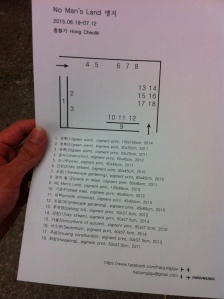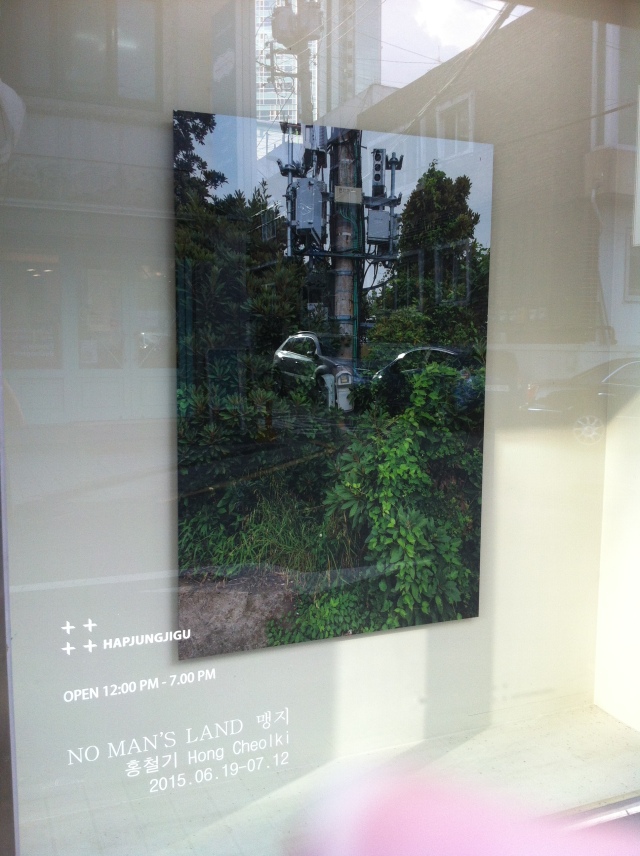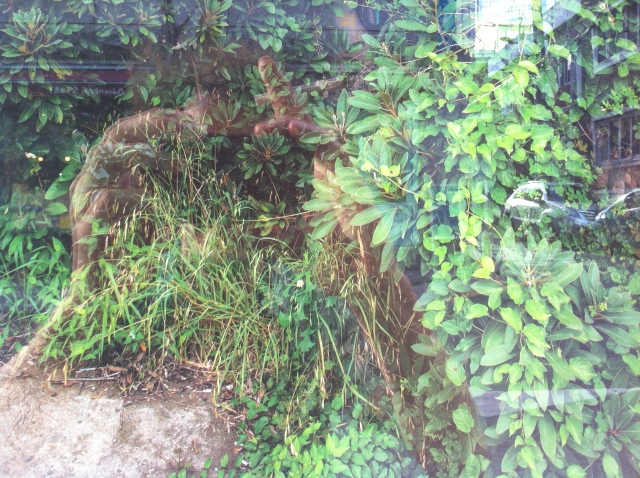The next opening at Hapjung Jigu is coming up already tomorrow (paintings by 이해민선, July 17 through August 9, see Facebook), still I wanted to note some of impressions of the last exhibition which I liked a lot and revisited several times during its three week run.
Walking down the alley, I could see the large green tree already from afar. It grows bigger and bigger as I approach and then, finally standing right in front of the window, there is a nice, little surprise.
 There is a lot of green in Hong Cheolki’s (홍철기) photos. But the one I like best, probably, is dominated by pale tones of blue and red-“mountains of autumn”. On first view, it seemed like piles of multi-colored powder, but of course it’s not…
There is a lot of green in Hong Cheolki’s (홍철기) photos. But the one I like best, probably, is dominated by pale tones of blue and red-“mountains of autumn”. On first view, it seemed like piles of multi-colored powder, but of course it’s not…
The best camera is the one you have with you all the time. The images shown here are for the most part taken on a cell phone and blown up to fit usual frame sizes. Rather than aiming for the perfect composition, these grainy photos rather show the spontaneity of the moment (of shooting, that is, not exactly of action, as there isn’t much going on usually), unexpected imagery in concrete contexts, and the curious beauty of the everyday. In this regard, they contrast with the paintings that have been shown here at Hapjung Jigu before, although none of those have been about technical perfection either.
The title, “No Man’s Land” or 맹지, lit. “Blind Spot” (as in ownerless piece of land, between two adjacent properties), is not to be taken lightly. There are no men present in the pictures (neither are women). Well, that’s what I thought when reconsidering the exhibition. Urban conclaves at night and day, signs of invisible life, work done recently, but no people. Really? No, I was proven wrong on the next visit. In fact, some images feature people, but they are not about those people.
The images, some of them taken years ago, some of them of more recent origin, show the silent clash of nature and culture, the cultivation of urban plants and the naturalization of the asphalt jungle. They show places that belong to no one. Real estate brokers would disagree, I’m sure. Nevertheless, the green and grey and the snow that melts on the concrete indicates a politics of place that goes beyond ownership and opens doors for visual appropriations of the city—our city.
– 19 June 2015 (金)
- 홍철기, 맹지, 합정지구, 2015년 6월 19일 ~ 7월 12일, 화-일: 오후 12시–7시.
- Hong Cheolki, No Man’s Land, Hapjung Jigu, 2015–06–19~07–12, Tue-Sun: 12–7pm.



interesting! I’ve thought Seoul is not that an attractive city at least to me, because of its ahistoricism and an excess of consumerism. Yet this shows any places have their own spot to breath.
Please check your email box, I forwarded info. ;)